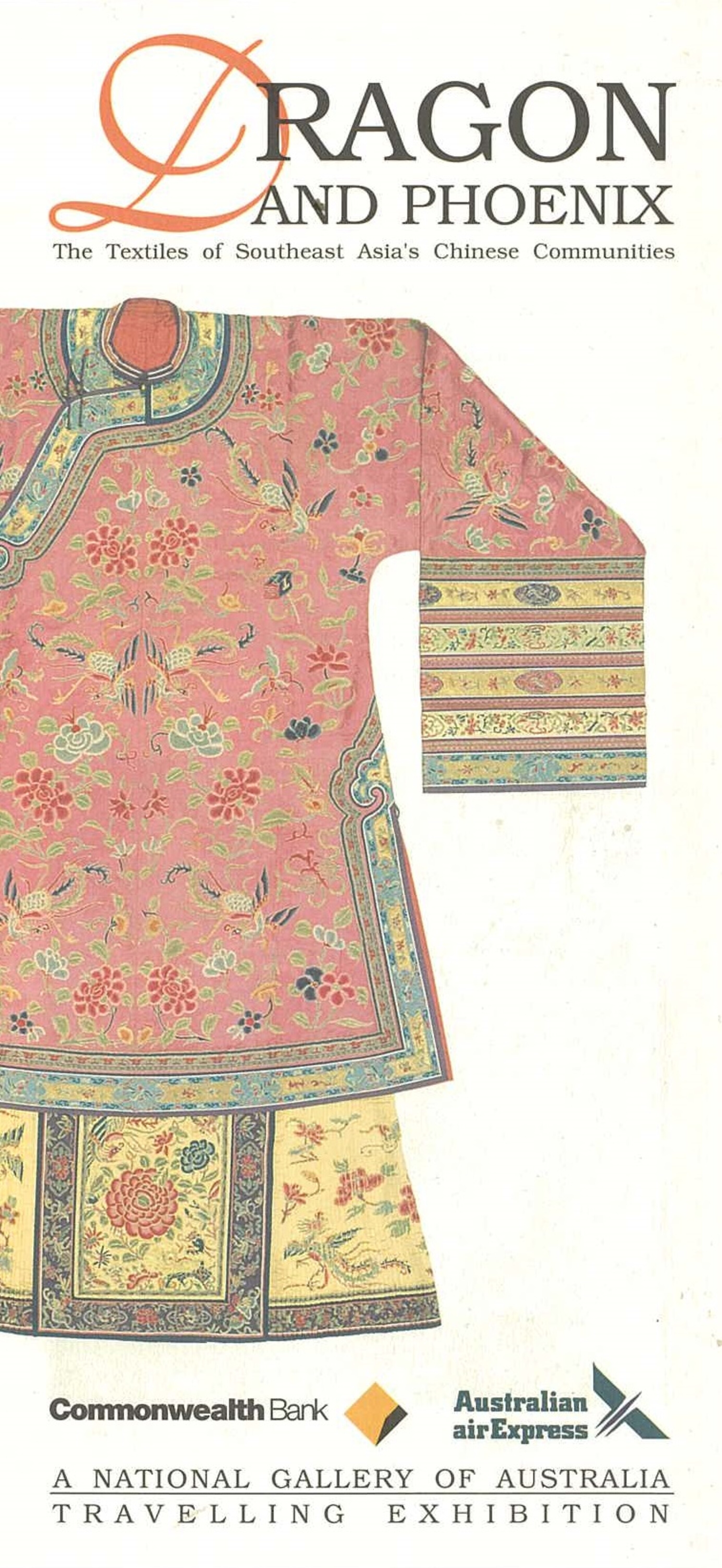This exhibition is now closed
Dragon and Phoenix
18 March –
18 May 1997

Textiles from Southeast Asia's Chinese communities.
Drawn largely from the extensive collection of Southeast Asian costumes and accessories in the Alice Smith collection at the National Gallery of Australia, this exhibition also includes pieces from an important private collection in Kuala Lumpur. Dragon and Phoenix highlights the pervasive Chinese influence found in the textiles and ceremonial objects of Southeast Asia.
For over 1,000 years there have been strong land and sea contacts between China and Southeast Asia. Visiting adventurers and traders stayed and centuries of intermarriage created communities that drew on the ritual and art of both the Chinese and the local traditions. Spectacular Chinese costumes were highly regarded by many Southeast Asian communities, so Chinese textiles and metal ornaments were incorporated into their own ceremonial dress. Their ceremonies have been marked by remarkable displays of textiles incorporating imported Chinese elements with the local Asian fabrics.
Dragon and Phoenix covers two interrelated themes ‒ the embroidered wedding costumes and accessories of the Straits Chinese communities of Malaysia and Singapore, and the ceremonial and everyday batik textiles of the Peranakan Chinese of the northern coastal towns of the Indonesian island of Java.
Some pieces were made in China, others in Southeast Asia. Amid the splendid textiles and decorations, are bridal regalia such as necklaces, shoes and ties, altar cloths and other sumptuous ceremonial furnishings. The 'cloud' collars and a Malay-style ornamental kerchief in this exhibition are amongst the finest examples of these spectacular embroideries ever publicly exhibited. Included, too, are several large embroidered garments, resplendent in brightly coloured silk and gold thread, which were worn as ceremonial costumes. Fabrics displayed as hangings and furnishings at weddings in the Chinese communities of the Malay peninsula, and batik altar cloths and related textile hangings used in Indonesian wedding ceremonies are also displayed.
The Indonesian cotton textiles of the Chinese communities living there are closely related to the Baba-Nonya blend of the Chinese with the Malay silk tradition. Hand drawn wax-resist batik was adopted by these Chinese for their ceremonial clothing, their everyday textiles and the Javanese-style garments like the wrap-around kain panjang and the tubular kain sarong.
The images depicted however remained distinctly Chinese. Whatever the decorative medium ‒ silk embroidery, gold thread couching, stump work, beadwork, batik or gold leaf gluework, these forms all display the distinctive Chinese motifs. From Chinese mythology came fanciful beasts like the dragon and phoenix, the dog-lion and the 'qilin' unicorn. Joining them were creatures like the deer, aquatic life including goldfish and lobsters, birds, floral emblems with peonies and lotuses, and the Chinese symbols for luck and wisdom.
Dragon and Phoenix is a National Gallery of Australia Travelling Exhibition programme and has been kindly supported by Australian Air Express. As well as giving a fascinating insight into traditional Chinese decorative motifs, it brings to Christchurch a unique opportunity to enjoy a rich array of exotic Southeast Asian fabrics and accessories.
Robyn Maxwell, lecturer in Asian Studies at the Australian National University, Canberra and the exhibition's curator, will be assisting with this exhibition, and, while in Christchurch, will extend our understanding and appreciation of these works with a public lecture at the Gallery on Sunday 16 March 'Dragon and Phoenix: Chinese influences on the textiles of Southeast Asia.' She will also address the Friends at the 19 March Speaker of the Month on 'Dragon and Phoenix: realistic and mythical creatures in the arts of Southeast Asia's Chinese communities.'
Also visiting is Sim Tan, a Southeast Asian art historian from Kuala Lumpur and a major textiles collector, who will speak on the textile arts of Southeast Asia at the Gallery on 20 March at 6pm.
This exhibition was held at the Robert McDougall Art Gallery in the Botanic Gardens.
Location:
Robert McDougall Art Gallery - main gallery
Exhibition number: 622